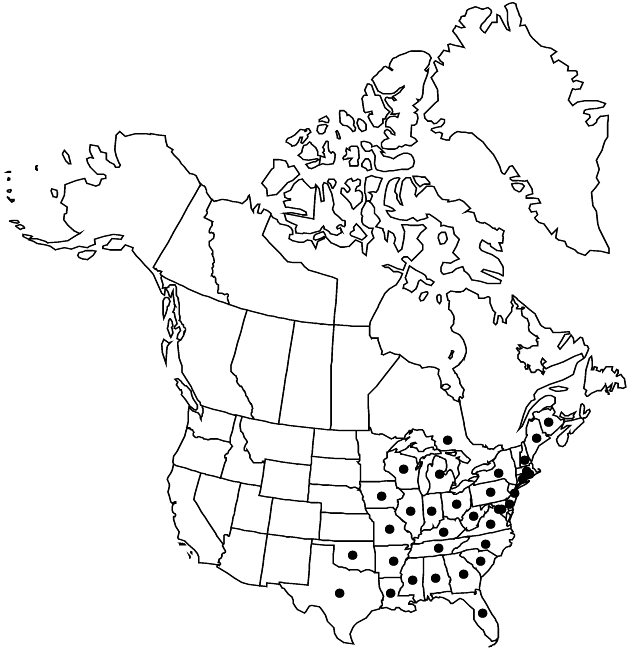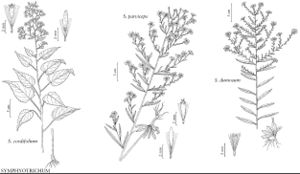Symphyotrichum dumosum
Phytologia 77: 280. 1995.
Perennials, (20–)30–100 cm, colonial or cespitose; usually long-rhizomatous, often thick, woody, sometimes short, or with short, stout caudices. Stems 1–5+, erect (straight, often slender, brittle), densely or sparsely strigose to glabrescent or glabrate. Leaves firm, margins entire to crenulate-serrate, recurved, scabrous, apices sharply white-mucronate, abaxial faces glabrous or glabrate to sparsely strigillose, adaxial glabrous or glabrate to submarginally scabrous (short-strigose), cauline withering by flowering (except on array branches), often with axillary leaf clusters; basal withering by flowering, petiolate, petioles winged, sheathing, strigose-ciliate, blades oblanceolate to spatulate (often declined), 8–50 × 3–15 mm, bases attenuate to cuneate, margins crenate-serrate, apices obtuse or rounded to ± acute; proximal cauline (mostly declined) subpetiolate (petioles widely winged, clasping) or sessile (then not or barely clasping), blades linear-oblanceolate, 25–120 × 1.5–9 mm, bases cuneate to slightly attenuate; distal (ascending or spreading) sessile, blades oblong or linear-lanceolate to linear, 2–45 × 0.5–4 mm, reduced distally (abruptly on branches), bases cuneate to rounded, not clasping, margins entire or serrate. Heads in remote, diffuse, open, paniculiform arrays, branches numerous, ascending to stiffly ascending, secondary ones stiff, racemiform (usually not secund). Peduncles slender, usually stiff (sometimes lax), (0.5–)1–5 cm (rarely subsessile), progressively reduced distally, usually not secund, sparsely strigillose or glabrous, bracts 5–16+, spreading to ascending, linear-oblong or -elliptic to subulate or linear, progressively reduced distally, grading into phyllaries. Involucres cylindro-campanulate, (3–)4.5–6.3 mm. Phyllaries in 4–6 series, appressed or slightly spreading, oblong-oblanceolate (outer) to linear-oblanceolate or linear (innermost), strongly unequal, bases indurate (1/2–)2/3–4/5, margins hyaline, scarious, erose, distally ciliolate, green zones oblanceolate to elliptic (subapical), apices acute to obtuse (scarious), sometimes faintly reddish, mucronulate, faces usually glabrous, sometimes glabrate. Ray florets 15–33; corollas pale blue, pink, or lavender to white, laminae (4–)5–7(–8) × 1–1.7 mm. Disc florets 15–30; corollas cream to pale yellow turning pink, 3.5–4.5 mm, tubes shorter than to equal to narrowly funnelform throats, lobes lanceolate, (0.4–)0.6–1.1 mm. Cypselae pink or stramineous with pink streaks, or gray (± dark, nerves stramineous), oblong-obovoid, sometimes ± compressed, 1.5–2.5 mm, 3–4-nerved (nerves prominent), faces strigillose; pappi white to sordid, 4 mm. 2n = 16, 32.
Phenology: Flowering Aug–Oct.
Habitat: Open or wooded, moist or wet soils, bogs, fens, sedge meadows, marshes, swamps, flood plains, sandy or calcareous flats, loamy prairies, old fields, sandhills, flatwoods, hammocks, pine-hickory woods, oak or pine thickets, secondary woods, sandy to mucky or marly shores of lakes and ponds, interdunal hollows
Elevation: 0–700 m
Distribution

N.B., Ont., Ala., Ark., Conn., Del., D.C., Fla., Ga., Ill., Ind., Iowa, Ky., La., Maine, Md., Mass., Mich., Miss., Mo., N.H., N.J., N.Y., N.C., Ohio, Okla., Pa., R.I., S.C., Tenn., Tex., Va., W.Va., Wis.
Discussion
Symphyotrichum dumosum is introduced in New Brunswick. It is widely cultivated. It can hybridize with S. racemosum and S. lanceolatum var. interior (A. G. Jones 1989). G. L. Nesom (1994b) and J. C. Semple et al. (2002) recognized several varieties within the complex: var. dumosum [syn. Aster coridifolius Michaux, A. dumosus Linnaeus var. coridifolius (Michaux) Torrey & A. Gray]; var. gracilipes (Wiegand) G. L. Nesom (syn. A. dumosus var. gracilipes Wiegand); var. pergracile (Wiegand) G. L. Nesom (syn. A. dumosus var. pergracile Wiegand); var. strictior (Torrey & A. Gray) G. L. Nesom [syn. A. dumosus var. strictior Torrey & A. Gray, A. dumosus var. dodgei Fernald, S. dumosum var. dodgei (Fernald) G. L. Nesom, the latter possibly the hybrid S. dumosum × S. boreale fide G. L. Nesom 1997]; and var. subulifolium (Torrey & A. Gray) G. L. Nesom (syn. A. dumosus var. subulifolium Torrey & A. Gray). Some of these taxa may deserve higher rank. More work is needed in the complex, however, before a coherent taxonomy can be achieved.
G. L. Nesom (1997) recognized also a southern pine flatwoods entity called Symphyotrichum kralii G. L. Nesom, based on the illegitimately named Aster pinifolius Alexander (not Nees, nor F. Mueller). The type of A. pinifolius, however, appears to be conspecific with that of S. simmondsii. At present, it seems best to wait for full investigation before formally recognizing such taxa.
Selected References
None.
